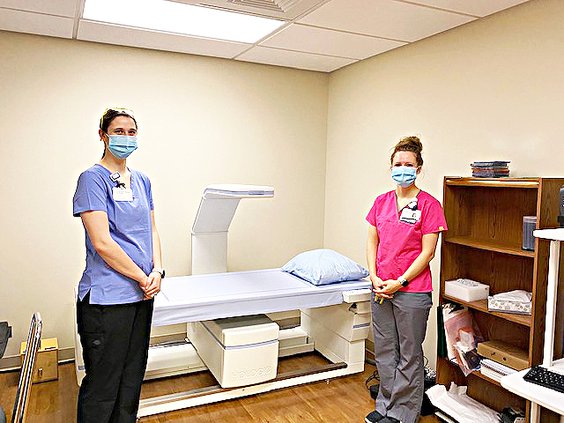LARNED — A new dexa scan unit was recently delivered to The University of Kansas Health System Pawnee Valley Campus, located at 923 Carroll Ave. in Larned and is up and running. The scanner promises enhanced image quality and takes even less time to test for bone density than the prior technology.
“The dexa scan is a wonderful preventive test that can identify bone loss early on,” said Shelly Stanton, director of imaging. “This means the patient can begin a treatment plan before a serious fracture occurs.”
A doctor’s referral is needed for the scan. The scan takes only 10 to 15 minutes. “It is quick, easy, painless, precise and non-invasive,” Stanton noted.
To prepare, patients are encouraged to wear clothing without zippers or other metal when possible. This is true for most imaging tests.
During a typical test, both hips and the low back are scanned. If the patient has had a hip replacement or spinal surgery, the technologist may scan the forearm.
Osteoporosis is detected by a dexa scan, which is the primary test for the condition. Other tests may indicate osteoporosis but a dexa scan is more precise and can confirm the diagnosis and its severity.
This is a condition in which bones become increasingly weak and brittle, which leads to a higher risk for fracture. Bones in osteoporotic patients can break as a result of only minor injuries.
Bone density normally starts to decrease around age 35 and often occurs more rapidly in post-menopausal women. There are usually no symptoms until a fracture occurs; bone loss can begin years before it is detected.
Risk factors include age, onset of menopause, smoking, some medications, excessive alcohol use, genetics, ethnicity, lack of exercise and diets lacking calcium and Vitamin D.
Chronic inflammatory conditions, bowel diseases, malabsorption disorders, family history and a small body frame also are risk factors. The test is available for men and women.
Treatments vary but can include vitamin supplements, dietary changes and/or medications. A physician may also suggest weight-bearing exercises.
“We encourage people who may be at risk to talk with their provider,” Stanton said. “Bone loss can cause damage for many years before detection. Spine fracture can lead to a hunching of the back. People with vertebral fractures are at a 20 percent greater risk for another such fracture within the next year.”
In addition, Stanton continued, a hip fracture can greatly reduce quality of life. Up to 30 percent of these patients require long-term care and up to 20 percent die within a year after the fracture.
“These are frightening statistics,” Stanton noted. “The good news is a dexa scan is a simple wellness test that detects bone loss early so that major fractures may be prevented.”
Melanie Urban, Pawnee Valley Campus administrator, noted the new scanner is “yet another example of offering enhanced healthcare services close to home. The community can be assured we will do everything possible to expand local options with our professionally trained and caring staff.”





